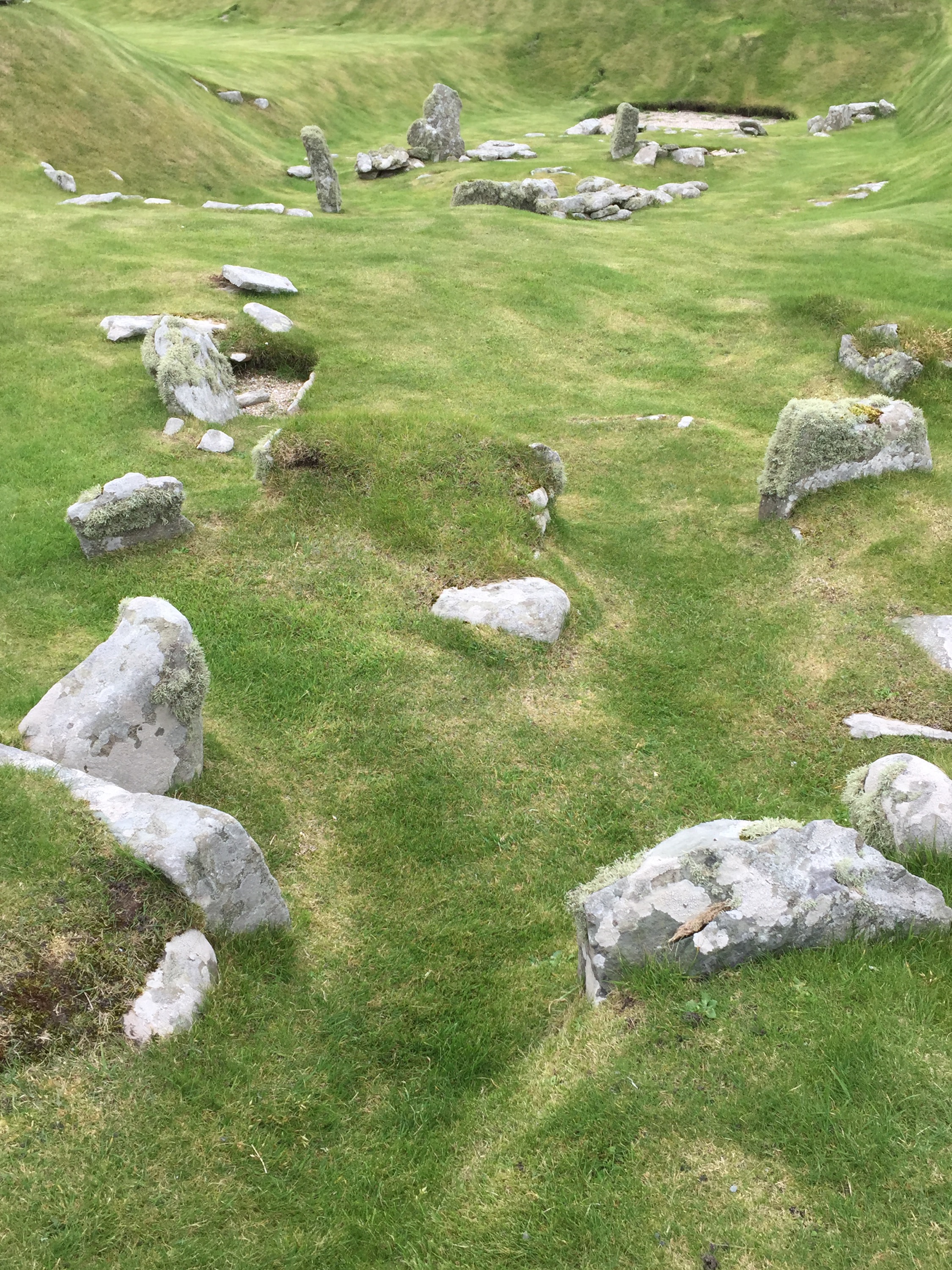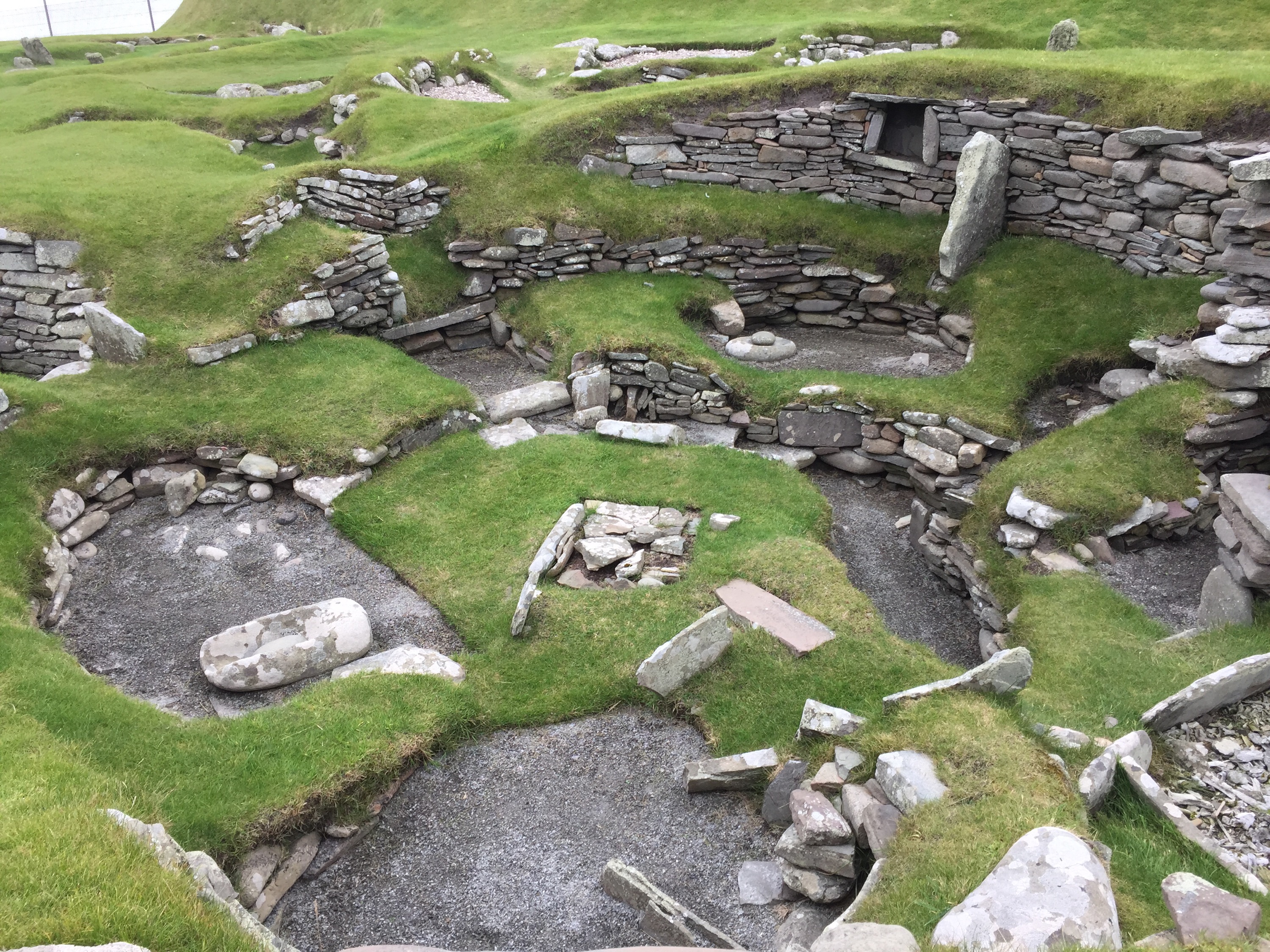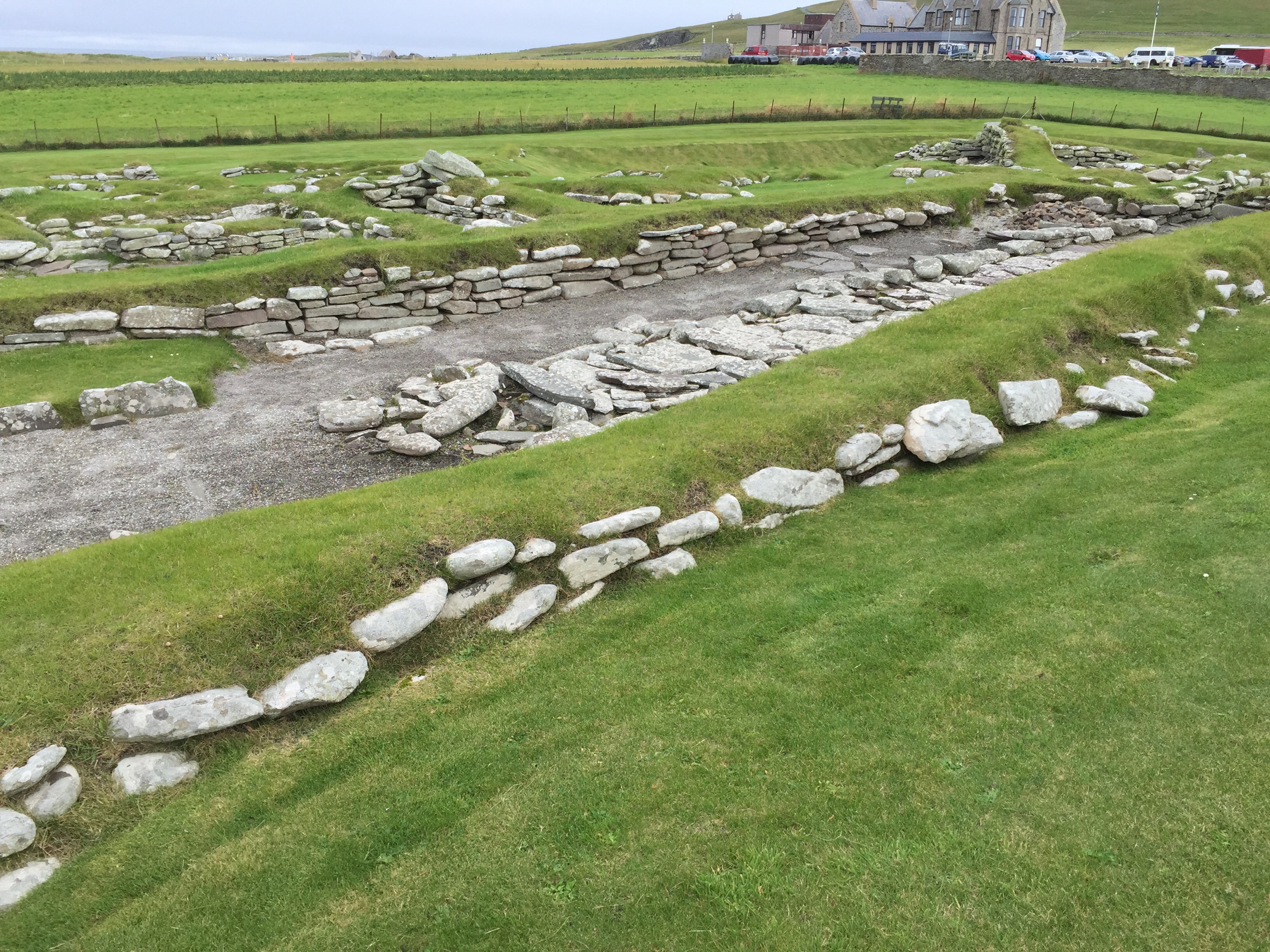Woo-hoo! I’m in the Shetland Islands! Last time I was Scotland was in 1995 with BigSal and BluddyMary as part of our huge Slappers Grand Tour of Europe, but we never made it quite this far north. The Shetlands are an archipelago of some 100 islands, barely 16 of which are permanently inhabited and today we visited Lerwick – pronounced either ‘Lerrick’ if you’re from any else where in Scotland or ‘Lerwick’, if you’re from the creatively named, Mainland – Shetland’s largest island. Lerwick, meaning literally, ‘muddy bay’ is a home to about 7,500 of the Shetland’s 23,000 people. It’s really sort of nice to be talking about population in the thousands after the ‘small towns’ of China coming in at around 5 million.
TIL Lerwick is officially only a town, not a city… In the UK, you have to have a cathedral and associated bishopric in order to be a city. I did not know that. Anyway, in the remote ‘township’ of Lerwick our first stop was Fort Charlotte. Built in 1665, Fort Charlotte is a coastal defense fort on the Bressay Sound during the Second Dutch War. It was reconstructed in 1781-82 during the American war of Independence and named after George III’s Queen. The Fort has a battery of cannon facing the Sound and is one of several pentagonal forts built around that time – much like the Dutch inspired pentagon fort we visited in Hakodate Japan a couple of months ago.
 After the Fort, we happened upon the Lerwick Town Hall, which might be the most beautiful civic building I have ever seen. With a gorgeous and imposing stone exterior, the town hall is comprised of offices and small conference rooms downstairs, and a function room upstairs in which every wall is covered in the most amazing stained glass l. The north wall had an enormous rose window covered with heraldry, one assumes belonged to important people connected to Lerwick, and the other two exterior walls were covered in windows depicting important persons from the Shetland’s Scottish/Scandinavian history. Absolutely stunning room for a town hall… actually scratch that, it was a stunning room to be in any sort of public building.
After the Fort, we happened upon the Lerwick Town Hall, which might be the most beautiful civic building I have ever seen. With a gorgeous and imposing stone exterior, the town hall is comprised of offices and small conference rooms downstairs, and a function room upstairs in which every wall is covered in the most amazing stained glass l. The north wall had an enormous rose window covered with heraldry, one assumes belonged to important people connected to Lerwick, and the other two exterior walls were covered in windows depicting important persons from the Shetland’s Scottish/Scandinavian history. Absolutely stunning room for a town hall… actually scratch that, it was a stunning room to be in any sort of public building.
 After admiring the stained glass we made our way down to Commercial Road and Market Cross to do a spot of shopping (again with the crazy creative names). We stopped in on some lovely knitwear stores, gift shops and some jewelry stores that all selling lovingly crafted local items inspired by the Shetlands and their traditional arts and crafts – including the famous Fair Isle knitwear. I particularly loved the De Rosa-Rinconada ceramics collection complete with gorgeous otters and puffins (totally would have bought some of these if I thought I could get them home safely), the Mirrie Dancers Northern Lights of the Shetlands jewelry collection (which I might have bought if they came in gold as well as silver) and the Fraser Knitwear (which I nearly did buy because it’s bloody cold!). I did buy a lovely woolen scarf (predictably, in burgundy) and of course a tourist pin for my collection. Mostly I’m just listing these other things here so I can look them up later. 😀
After admiring the stained glass we made our way down to Commercial Road and Market Cross to do a spot of shopping (again with the crazy creative names). We stopped in on some lovely knitwear stores, gift shops and some jewelry stores that all selling lovingly crafted local items inspired by the Shetlands and their traditional arts and crafts – including the famous Fair Isle knitwear. I particularly loved the De Rosa-Rinconada ceramics collection complete with gorgeous otters and puffins (totally would have bought some of these if I thought I could get them home safely), the Mirrie Dancers Northern Lights of the Shetlands jewelry collection (which I might have bought if they came in gold as well as silver) and the Fraser Knitwear (which I nearly did buy because it’s bloody cold!). I did buy a lovely woolen scarf (predictably, in burgundy) and of course a tourist pin for my collection. Mostly I’m just listing these other things here so I can look them up later. 😀
Next on our agenda was the Shetland Museum and Archive. Situated down on the waterfront this free museum is full of all the cool history of the Shetlands spanning back to the Stone Age. I took so many photos here of Scots, Norse and Viking artifacts that I think it might have to go into a post of its own to keep it all straight… The museum covered everything local from stone axes through to Victorian mourning attire. It was very interesting.
After having been wait listed to get on a ship your to visit the Jarlshof Ruins, I can’t tell you how pleased and relieved I was to be getting the chance to see this unique site – and that is what our afternoon had in store for us. We met up with our tour group back at the tender pier and set off with our local guide, Melvyn, towards the ruins.
On the way there, Melvyn caught us up on plenty of local Shetland colour and trivia. Housing in Lerwick can be as much as £500,000 with the price going up the further up the hillside the property was located. All the ‘wicks’ – Sanwick, Hoswick, Lerwick – refer to square shaped bays. The little Shetland ponies we saw as we were driving through the countryside were originally beasts of burden, particularly sturdy and useful for collecting peat, but now are of little commercial use, but people love them anyway. In fact, Shetland ponies and sheep are the only domestic animals that thrive up here, and I can fully believe it – conditions today at the end of summer were a bit iffy, but it looked like it would be downright bleak in winter. What else? Ahhh, the locals believe that if the cows are sitting down its a sure sign it’s going to rain (not a bad bet – they seem to have pretty high average rainfalls). And the black fishing nets that seem to live on every other street corner are used to cover rubbish to keep seagulls out of the trash. He told us how people used to harvest peat from the bogs by cutting it into banks to use as winter fuel, but this was falling out of fashion as it is very labour intensive and time consuming. It’s hard work to dig up the peat, it takes weeks to dry it out and you have to transport it home. Peat is like a precursor to coal and is a finite resource as it doesn’t replenish… But Melvyn seemed to think Scotland had plenty of it and mentioned that some people were turning back to peat due to the rising cost of oil and other fuels. I wasn’t aware of this, but a large storms can shift an entire peat bogs by causing landslides when the water gets underneath the peat layer. He also told us how many Shetland graveyards are located close to the coastlines, as many visitors coming to funerals and to grave sites, are often coming by boat. Melvyn was full of weird and wonderful informative tidbits… And I just realized I probably should have dot pointed that wall of text, but too bad! 🙂
Then there were the Jarshof Ruins, that evidences 5000 years of continuous and uninterrupted human history. It is rightly considered the most important historic site of the Shetlands and no doubt lists right up there with Newgrange in Ireland for somewhat obscure yet intrinsically important historical sites worldwide that document human history.
 Jarlshof, literally means, ‘earls house’ and the site provides evidence for how humans had lived uninterrupted in the area from the Neolithic Period right up until the 1600s. Each new era building beside, rather than on top of, their predecessors dwellings… So in a rather condensed space you can see how people moved from one area to the next, abandoning the previous building styles.
Jarlshof, literally means, ‘earls house’ and the site provides evidence for how humans had lived uninterrupted in the area from the Neolithic Period right up until the 1600s. Each new era building beside, rather than on top of, their predecessors dwellings… So in a rather condensed space you can see how people moved from one area to the next, abandoning the previous building styles.
Originally the archeological site would have been far more extensive, but it’s precarious location by the sea has seen much of the site destroyed by erosion. What remains however is fascinating. The site was unearthed in 1905 unearthed by a storm which gave a glimpse to the stone work below what would have looked like an ordinary grassy mound. Excavation of the area commenced and in 1925 the site was claimed as a historic site. In 1950 all excavation was finished and the site is now as it was then. Visitors can move through the complex and observe the changing conditions of the people who lived here at the different eras…
Neolithic period is the oldest period represented as being the earliest dwellings on site. Pottery fragments dating from 2500BC were found in these late stone age period residences, dating this section of the ruins to be 4500 years old.
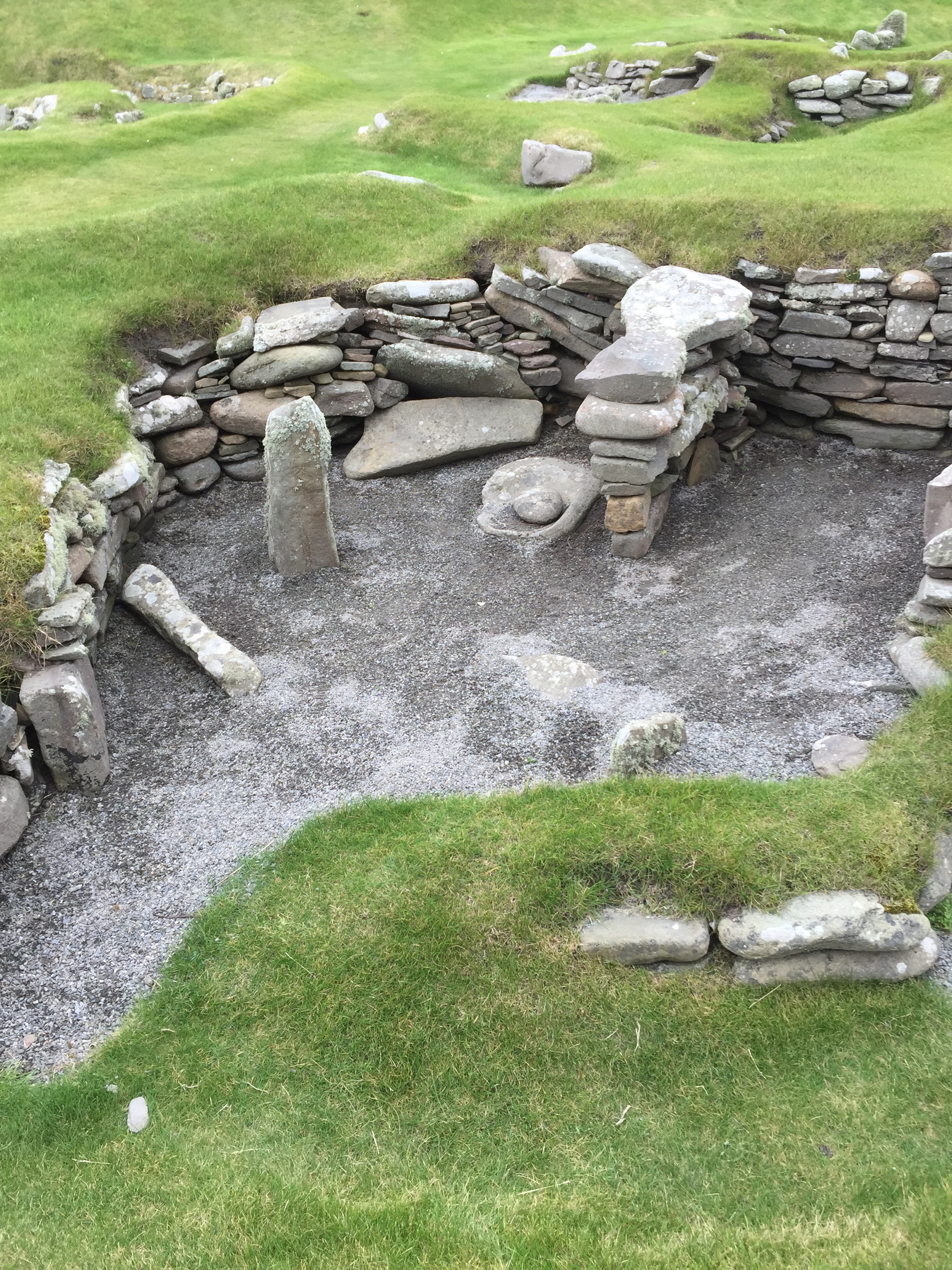 Further on are Bronze Age dwellings, the age of which was (obviously) determined by objects made of bronze in what was a working smithy. Remarkable about these bronze finds is they also provide evidence of extensive trade some 4000 years ago – bronze, as we know, is a copper and tin alloy, and while the Shetlands do have copper deposits and copper mines, the nearest tin mines are in Cornwall in the very south of England and must have been traded north. The bronze artifacts found here are similar those those found in Dublin from the same period. The residences in these Bronze Age homes were rounded alcoves that would have had conical wooden roofs… Though wood is no longer plentiful in the Shetlands.
Further on are Bronze Age dwellings, the age of which was (obviously) determined by objects made of bronze in what was a working smithy. Remarkable about these bronze finds is they also provide evidence of extensive trade some 4000 years ago – bronze, as we know, is a copper and tin alloy, and while the Shetlands do have copper deposits and copper mines, the nearest tin mines are in Cornwall in the very south of England and must have been traded north. The bronze artifacts found here are similar those those found in Dublin from the same period. The residences in these Bronze Age homes were rounded alcoves that would have had conical wooden roofs… Though wood is no longer plentiful in the Shetlands.
The next residences belong to the Early Iron Age and are similar in construction (conjoined round alcove housing) to the Bronze Age homes but are slightly more elaborate in comparison. They have also found several soutterrains – underground natural fridge spaces in two of the Early Iron Age dwellings.
 The Mid Iron Age homes nearby are in the form of a typical Scottish broch – a multi storied round stone building that would have housed several families living in one space. The circular, double brick building had no windows and a timber roof and were built up to 15m high and approximately 16m across at the base. The broch at Jarlshof was built around 400BC-100AD and only half on the circular building remains as the other half has long since been claimed by the sea.
The Mid Iron Age homes nearby are in the form of a typical Scottish broch – a multi storied round stone building that would have housed several families living in one space. The circular, double brick building had no windows and a timber roof and were built up to 15m high and approximately 16m across at the base. The broch at Jarlshof was built around 400BC-100AD and only half on the circular building remains as the other half has long since been claimed by the sea.
 The next era represented is the Late Iron Age ‘wheelhouses’ which were built approximately 200-300AD. So named because they resemble a wheel when viewed from above, the wheelhouses again had no windows, were circular in construction, but this time had only one entrance, a small central ‘hall/hearth’ area with alcoves emitting from the central space. The stone pillars supporting the ‘spokes’ widen as they are built higher providing a triangular support which would have enabled a heavier stone and timber roof. Again these wheelhouses housed several families in one structure and would have been particularly cramped – with storage areas but no sleeping areas, people probably huddled together to sleep rather than laid down.
The next era represented is the Late Iron Age ‘wheelhouses’ which were built approximately 200-300AD. So named because they resemble a wheel when viewed from above, the wheelhouses again had no windows, were circular in construction, but this time had only one entrance, a small central ‘hall/hearth’ area with alcoves emitting from the central space. The stone pillars supporting the ‘spokes’ widen as they are built higher providing a triangular support which would have enabled a heavier stone and timber roof. Again these wheelhouses housed several families in one structure and would have been particularly cramped – with storage areas but no sleeping areas, people probably huddled together to sleep rather than laid down.
 From there the next period is that of the Viking longhouses from approximately 800AD. The Viking Norsemen came to Scotland looking for farming land – as there were limited agricultural lands left in various Scandinavian/Viking areas. The change in architecture is very noticeable. Gone are the round alcove housing and in their place the long rectangular Viking longhouses are apparent. Corners are square, buildings are more structured, people lived at one end of the long house and animals at the other. Future houses were built perpendicular to the main Viking longhouse. The Vikings brought to Scotland their language, their building techniques and their boat building techniques… much of which is still evident in the modern Shetlands.
From there the next period is that of the Viking longhouses from approximately 800AD. The Viking Norsemen came to Scotland looking for farming land – as there were limited agricultural lands left in various Scandinavian/Viking areas. The change in architecture is very noticeable. Gone are the round alcove housing and in their place the long rectangular Viking longhouses are apparent. Corners are square, buildings are more structured, people lived at one end of the long house and animals at the other. Future houses were built perpendicular to the main Viking longhouse. The Vikings brought to Scotland their language, their building techniques and their boat building techniques… much of which is still evident in the modern Shetlands.
After the Viking period which flourished for some 400 years came the Medieval farmhouse, which was established around 1200AD and was characterized by yet another style of building. These buildings were of drystone construction and had internal and external walls with an earthenware core.
 Following on from the Medieval farmhouses, the most recent buildings wee from the period where the Scottish took over the Shetlands. The Scottish period started when James III of Scotland married Margaret, daughter of King Christian of Denmark in 1469. Margaret brought the Shetlands as dowry to James III, and even though Christian intended to eventually purchase them back, he never had the capital. For some time the property remained occupied by the Norwegian Sumburghs. Eventually, the Laird’s House and Hall were built and given to Sir Robert Stewart (an illegitimate uncle to James VI) to maintain Scottish governorship of the Shetlands. In 1593 Earl Robert died leaving the property to his son, Earl Patrick Stewart who built further on the property in the rubble bedded lime and mortar style. Earl Patrick met a messy end after being arrested and incarcerated for six years for tyrannous treatment of his tenants. Eventually he was executed in 1615 (the six years of incarceration was apparently because he had to recite the Lord’s Prayer before being executed, and because he was illiterate and took him that long to learn it…stalling much?). After the Stewarts downfall, the Scottish Bruce family took over but without being occupied, by the end of the 1600s the buildings were in ruins.
Following on from the Medieval farmhouses, the most recent buildings wee from the period where the Scottish took over the Shetlands. The Scottish period started when James III of Scotland married Margaret, daughter of King Christian of Denmark in 1469. Margaret brought the Shetlands as dowry to James III, and even though Christian intended to eventually purchase them back, he never had the capital. For some time the property remained occupied by the Norwegian Sumburghs. Eventually, the Laird’s House and Hall were built and given to Sir Robert Stewart (an illegitimate uncle to James VI) to maintain Scottish governorship of the Shetlands. In 1593 Earl Robert died leaving the property to his son, Earl Patrick Stewart who built further on the property in the rubble bedded lime and mortar style. Earl Patrick met a messy end after being arrested and incarcerated for six years for tyrannous treatment of his tenants. Eventually he was executed in 1615 (the six years of incarceration was apparently because he had to recite the Lord’s Prayer before being executed, and because he was illiterate and took him that long to learn it…stalling much?). After the Stewarts downfall, the Scottish Bruce family took over but without being occupied, by the end of the 1600s the buildings were in ruins.
 1969 saw the 500th anniversary of the Union of the Shetlands into Scotland which was marked by finally designing a Shetland flag – being a beautifully simple, ‘Azure, an offset cross Argent’. The design is intended to equal symbolic weight to the fact that Shetland was part of Norway for 500 years and Scotland for 500 years, so it is a combination of the typically Scandinavian offset cross and the national colours of Scotland. Very cool… But I wonder what took them so long.
1969 saw the 500th anniversary of the Union of the Shetlands into Scotland which was marked by finally designing a Shetland flag – being a beautifully simple, ‘Azure, an offset cross Argent’. The design is intended to equal symbolic weight to the fact that Shetland was part of Norway for 500 years and Scotland for 500 years, so it is a combination of the typically Scandinavian offset cross and the national colours of Scotland. Very cool… But I wonder what took them so long.
Other than all these crazy cool things, the Shetlands are known for fishing and fish processing – including salmon and mussels and all good seafoody things. They’re also pretty reliant on oil and natural gas, tourism and agriculture. The only other thing the Shetlands are really known for are their midgees…. Fucking annoying little sand flies getting about biting you when ever the wind dies down. I don’t think I could live in a place that had them year round like this. Little buggers.
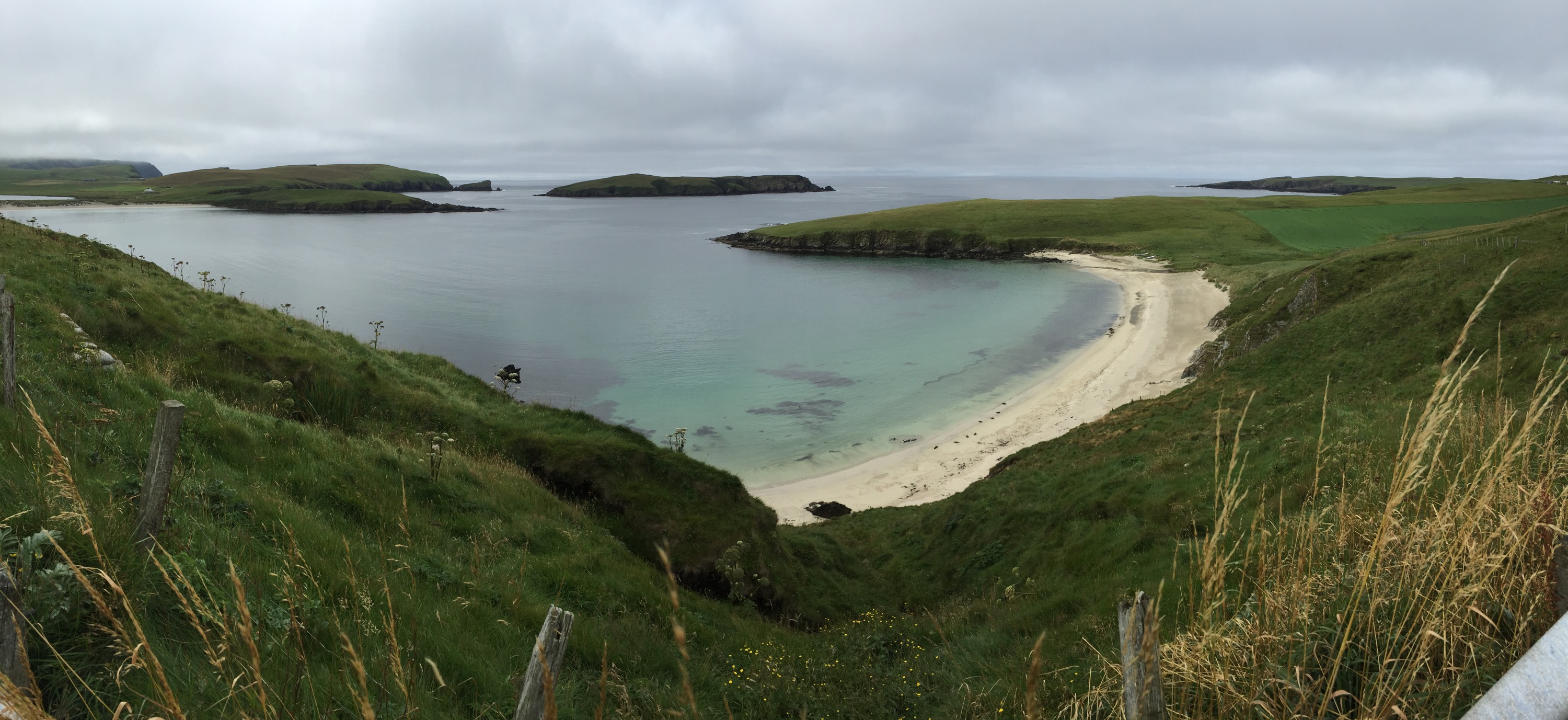
Then there’s the Up-Helly-Aa Fire Festival that is held on the last Tuesday of every January to mark the end of winter. About 800-900 torch bearers walk through the streets in full Viking costumes to the main park in town for the main event of the festival which is the burning of a Viking long ship! People spend months making their Viking costumes (sound familiar?) and the festival lasts nearly 24 hours ending in the 2.5mile procession where participants then throw their torch into the longship. Participants are called Guizers and they follow the GuizerJarl or Earl of the Festival. There is also a junior Up-Helly-Aa held with about 120 kids. Much like the Iditarod – I think it’s something I’d love to attend but can’t quite see myself coming to the Shetlands or Alaska in the winter time!
Oh, and tomorrow marks the day that Queen Elizabeth II breaks Queen Victoria’s record as longest serving British monarch. I wonder if the royalists will be celebrating in the streets back in London… If they are, we will unfortunately miss it as we will be on the open sea heading for Iceland via the Arctic Circle! 😀




